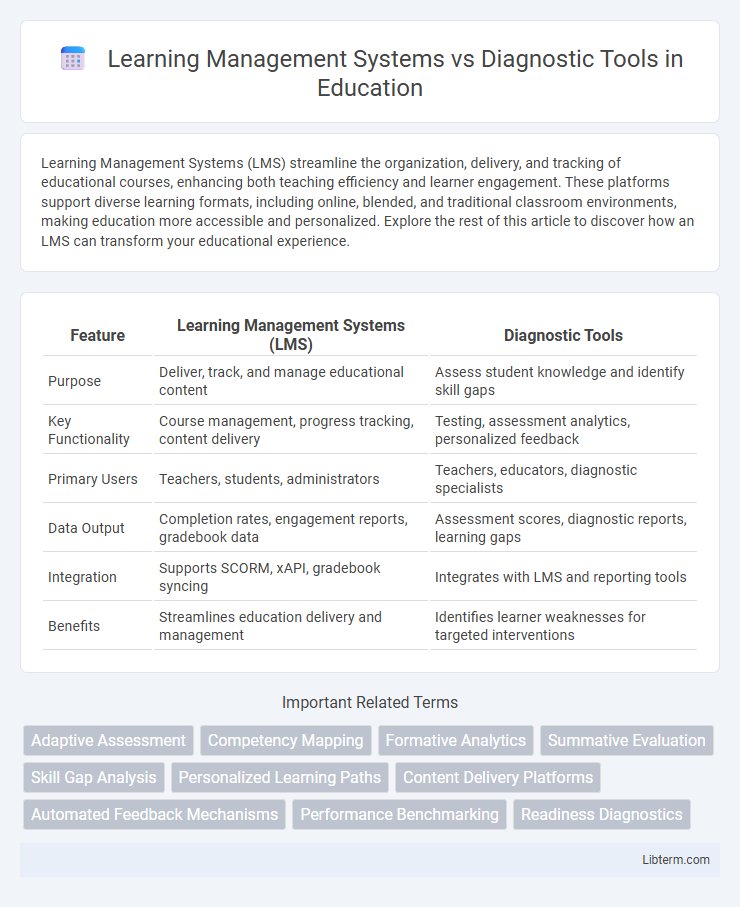Learning Management Systems (LMS) streamline the organization, delivery, and tracking of educational courses, enhancing both teaching efficiency and learner engagement. These platforms support diverse learning formats, including online, blended, and traditional classroom environments, making education more accessible and personalized. Explore the rest of this article to discover how an LMS can transform your educational experience.
Table of Comparison
| Feature | Learning Management Systems (LMS) | Diagnostic Tools |
|---|---|---|
| Purpose | Deliver, track, and manage educational content | Assess student knowledge and identify skill gaps |
| Key Functionality | Course management, progress tracking, content delivery | Testing, assessment analytics, personalized feedback |
| Primary Users | Teachers, students, administrators | Teachers, educators, diagnostic specialists |
| Data Output | Completion rates, engagement reports, gradebook data | Assessment scores, diagnostic reports, learning gaps |
| Integration | Supports SCORM, xAPI, gradebook syncing | Integrates with LMS and reporting tools |
| Benefits | Streamlines education delivery and management | Identifies learner weaknesses for targeted interventions |
Introduction to Learning Management Systems (LMS)
Learning Management Systems (LMS) serve as centralized platforms designed to streamline the administration, documentation, tracking, and delivery of educational courses or training programs. These systems facilitate content management, learner enrollment, progress monitoring, and assessment integration, enhancing the overall learning experience. Unlike diagnostic tools, which primarily identify learner strengths and weaknesses through assessments, LMS platforms provide comprehensive infrastructure for hosting, managing, and delivering a wide range of educational content and activities.
What Are Diagnostic Tools in Education?
Diagnostic tools in education are specialized software applications designed to assess students' knowledge, skills, and learning gaps through targeted evaluations and data analysis. These tools provide educators with detailed insights into individual and group performance, enabling personalized instruction and early identification of learning difficulties. Unlike Learning Management Systems (LMS), which primarily facilitate content delivery and course management, diagnostic tools emphasize assessment accuracy and actionable feedback to improve student outcomes.
Core Functions of LMS vs Diagnostic Tools
Learning Management Systems (LMS) primarily facilitate the administration, documentation, tracking, and delivery of educational courses or training programs, emphasizing content management and learner progress monitoring. Diagnostic tools concentrate on assessing learner capabilities by identifying knowledge gaps, skill deficiencies, and personalized learning needs through targeted evaluations. While LMS enable structured learning experiences and reporting, diagnostic tools provide actionable insights to tailor instruction and improve learner outcomes.
User Experience and Interface Comparison
Learning Management Systems (LMS) typically offer a structured, user-friendly interface designed for course navigation, progress tracking, and content interaction, enhancing seamless accessibility for learners. Diagnostic tools emphasize intuitive data visualization and real-time feedback mechanisms to diagnose learner strengths and weaknesses, prioritizing clarity in reporting. Comparing both, LMS interfaces focus on engagement and content delivery, while diagnostic tools optimize user experience for assessment accuracy and actionable insights.
Data Collection and Analytics Capabilities
Learning Management Systems (LMS) provide comprehensive data collection on learner progress, course completion rates, and engagement metrics, enabling detailed tracking of individual and group performance. Diagnostic tools focus on in-depth assessment data, capturing specific skill gaps and knowledge deficiencies through advanced analytics and real-time feedback. Combining LMS and diagnostic tools enhances overall data-driven decision-making by integrating broad learning trends with targeted diagnostic insights for personalized education strategies.
Personalization and Adaptive Learning Features
Learning Management Systems (LMS) offer robust personalization by tracking user progress and customizing content delivery based on individual learning paths. Diagnostic tools enhance adaptive learning features by accurately assessing skill gaps and providing real-time insights for targeted interventions. Combining LMS with diagnostic tools creates a dynamic learning environment that continuously adjusts to meet each learner's unique needs.
Integration with Other Educational Technologies
Learning Management Systems (LMS) offer seamless integration with a wide range of educational technologies such as video conferencing tools, content authoring software, and assessment platforms, enabling a cohesive learning environment. Diagnostic tools specialize in analyzing student performance data and can be integrated into LMS to provide personalized learning paths and targeted interventions. Effective integration between LMS and diagnostic tools enhances data-driven decision-making and supports adaptive learning strategies within digital education ecosystems.
Benefits and Limitations of LMS
Learning Management Systems (LMS) provide scalable content delivery, centralized tracking, and automated assessments, enhancing organizational learning efficiency. They support diverse multimedia resources and facilitate user progress monitoring but may lack in-depth diagnostic capabilities to pinpoint specific knowledge gaps. Limitations include potential high setup costs, dependency on stable internet connectivity, and sometimes rigid structure that can restrict personalized learning paths.
Strengths and Weaknesses of Diagnostic Tools
Diagnostic tools excel in pinpointing specific learning gaps through real-time data analysis, enabling targeted interventions that boost learner outcomes. Their strength lies in adaptive assessments and detailed analytics that provide personalized feedback, but they often lack the comprehensive course management features found in Learning Management Systems (LMS). Limited integration capabilities and dependency on accurate data input can undermine their effectiveness compared to the broader functionality of LMS platforms.
Choosing the Right Solution: LMS, Diagnostic Tools, or Both?
Choosing the right solution depends on organizational goals: Learning Management Systems (LMS) deliver structured course delivery, progress tracking, and compliance management, while diagnostic tools specialize in assessing learner knowledge gaps and skill deficiencies through data-driven insights. Integrating both LMS and diagnostic tools can enhance personalized learning paths by combining content management with targeted assessments, thereby improving learner engagement and outcomes. Evaluate factors such as scalability, user experience, reporting capabilities, and specific training needs to determine if a single platform or a complementary combination better supports your educational strategy.
Learning Management Systems Infographic

 libterm.com
libterm.com